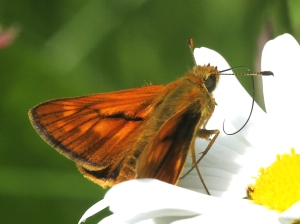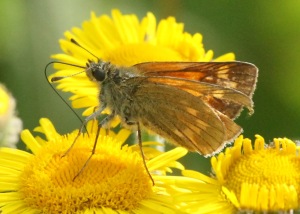The Large Skipper, Ochlodes sylvanus
The Large Skipper is a bit of a “blunt” butterfly – Skippers often have a moth-like appearance – they don’t flutter like other butterflies but zip, skip or buzz from one place to another – hence the name. Large Skippers are usually the first of the group that you notice as they are rather more widespread. On first sight they appear “mottled” rather than a uniform clear orange.
Description
The first impression is of a small and stocky dark-orange butterfly with pale splodges. This one appears to be a male, with the dark sex-brand running diagonally across the fore-wing:

This individual might be a female:

Distribution
Large Skippers can be found in most parts of the parish, in woodland rides or the agricultural areas, wherever there are coarse tufty native grasses, so they are relatively rarely seen in gardens, within the villages at least – but they are occasionally found! They appear to be the most widely spread skippers in the parish. For example, I have seen them quite a lot in Dene Park, on the brambles on MT133 along the Access Trail and along the path MT114 from the college up towards Stallion Green.
In the UK, Large Skippers are basically found throughout England and Wales, but so far have only reached Dumfries and Ayrshire on the west coast of Scotland (although they may be moving slowly northward). They are not native to Ireland. Individual colonies are normally small, except where large areas of rough grass are created, such as in woodland creation areas like White Horse Wood Country Park. Although the range is slightly increasing northwards, total population has decreased somewhat since the 1970s due to habitat loss (about 12%), with some apparent reversal of this trend in the last two decades.
Internationally, Large Skippers can be found across much of Europe and temperate Asia as far as Japan.
Life cycle
As is normal in the Skipper family in the UK at least, the Hesperiidae, there is only one generation of the adult butterflies in a year, and Large Skippers may be found flying from May to August, although most are seen in June and July.
Male Large Skippers are active in hot weather, nectaring, or perching/patrolling for females. Patrolling by the males is generally commonest in the later part of the morning, zipping between likely spots and then slowly searching for females around grass clumps until they are close enough to be smelt. In the early morning and in the afternoon though, perching, probably on a much-contested waist-high leaf in a sunny sheltered spot, is the commoner activity. The males leap from these vantage points at any passing insects, and if they turn out to be passing males, the clashing of wings in the resulting combats can be quite easily heard. If the passing insect is a female however, a courtship flight to a suitable vantage point is (hopefully) followed by the courtship process itself.
The females rest a lot while intermittently and carefully laying single eggs, usually in the early afternoon. The grasses chosen are quite often the lush leaves of Cocksfoot, often using large clumps of the grass in exposed situations.
The eggs hatch in a couple of weeks and the caterpillars eat their eggshells, and then bind the leaf into a tube with silk, from which they periodically emerge to nibble at the leaf edges. The caterpillars are green with brownish heads. They over-winter and then in the spring emerge to feed further, perhaps binding several leaves together, and then pupation (for about three weeks) takes place eventually in May-June, with the pupae rolled up in leaves low down on the plant. Thus, the caterpillar stage generally lasts for about 11 months of the year.
Oddities
As the Large Skipper is not found in Ireland and a large number of the smaller islands, it is generally supposed to be a late coloniser across the English Channel after the end of last glaciation.
Predator and parasites
No information.